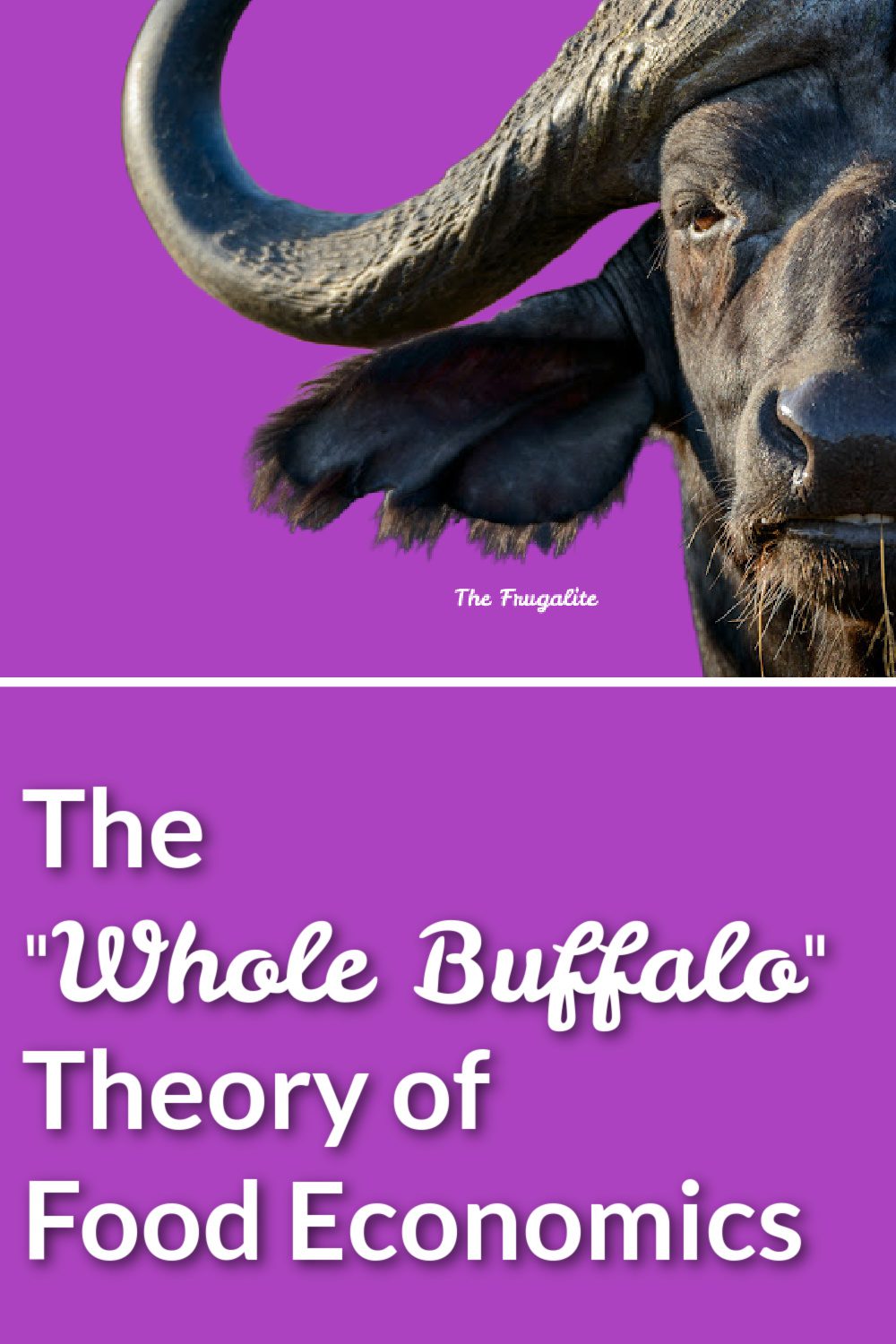(Psst: The FTC wants me to remind you that this website contains affiliate links. That means if you make a purchase from a link you click on, I might receive a small commission. This does not increase the price you’ll pay for that item nor does it decrease the awesomeness of the item. ~ Daisy)
by the author of The Ultimate Guide to Frugal Living and The Prepper’s Canning Guide
Have you ever considered how your personal food economics may be impacting your monthly budget? Until you take a good, hard look at what you’re spending by tossing into your trash can, you’ll never be as frugal as possible. But what does this even mean? What is food economics? What is the whole buffalo theory? Let’s take a look…
Why is using the whole buffalo essential in food economics?
In Native American lore, it is often said that hunters made use of the entire animal they had killed in order to respect the sacrifice which sustained them. The buffalo was considered to be sacred, and it was felt to be an offense to be wasteful. They ate anything edible; used the hides for shelters, shoes, and clothing; they strung bows with the sinews, they used the stomachs as water canteens, and they used the horns for weapons and tools.
The other day when I was preserving some peaches, my daughter pointed out that I was letting some parts go to waste. She said, “Mom, you need to use the whole buffalo!”
So, I began to do some reading. I broke out all of my vintage cookbooks, began scouring the internet, and discovered that in this day and age, we sure do waste a lot of our buffalo.
For many of us, budgets are tight. Whole, organic food is expensive, so in order to get our money’s worth, we need to be creative and make it go as far as possible.
Back to peaches.
Over the past couple of weeks, I’ve had my hands on nearly 100 pounds of fresh juicy peaches from the orchard less than a mile from my house. Fifty pounds in, Rosie pointed out that the pits and peels might be able to be used for something other than adding to our compost pile. So here’s what we did with the peaches:
- Jars of decadent Vanilla Spiced Peaches
- Jars of Brown Sugar Peach Preserves
- Jars of Spicy Peach Jam
- Jars of Sweet Lemon Peaches
- Peachsicles
- Peach Peel Candy (they taste a lot like Fuzzy Peaches candies but they aren’t made of nasty chemical ingredients)
- Peach Ice Tea (from the pits)
- Peach Vodka (still brewing in a cool dark place)
- Jars of Peach Pit Syrup
The only stuff that got tossed in the compost were the funky spots on the skin and the occasional mushy spot that we cut out and discarded. The only equipment we used was a waterbath canner and a dehydrator.
Growing food is sort of like having a baby.
When you put forth the effort to grow your own food, you realize how much work goes into it and you are far less likely to take it for granted. Sort of like carrying a baby around for 9 months then pushing it out. You’re going to take good care of anything that is that much work. 😉
Okay, it’s really not that much like having a baby, but go with my analogy – it’s too much work to be careless with the results.
When you begin to shift to a more agrarian lifestyle, you begin to realize that although there is so much more food than you could ever consume at the moment, that food won’t be around forever. Berry season is fleeting, peaches are only here for a few short weeks, and tomatoes are in their glory only for the hottest part of the summer.
If, like me, you intend to stop shopping at the conventional grocery store, you are going to need to make the most of this bounty while it’s here, or winter is going to be long and bland. Our ancestors managed fine without “fresh” blueberries and tomatoes in December, and with a little food preservation effort, you can too.
So, don’t be shy about buying vast amounts of **this-week’s-yumminess*** at the farmer’s market this weekend. With a little bit of research, you can make it go much further than one decadent meal. You even make some things last until next year!
This is very budget friendly.
People ask me all the time how my family can afford to eat an organic, local diet on a tight, single mama budget. While it’s true that the food we purchase often costs more than the food at the grocery store, the quality is so good that a simple slice of tomato is positively decadent. We actually find that we are far more satisfied with the delicious, chemical-free honest-to-goodness food that we eat compared with chemical-laced crap.
However, we still have to fill our tummies on more than a single slice of tomato. That’s why I go out of my way to find free food.
Yep, it exists.
I have always considered anything you make from stuff that other people throw away to be free food. And free food is a great way to improve your food economics.
There actually is such a thing as a free lunch. It consists of soup made from that chicken carcass that your family picked nearly clean at dinner last night, cooked along with those onion and veggie scraps that you kept in the freezer for the specific purpose of making a future soup. Most meals for a family of four cost between $10-20 when prepared at home, so if you make one freebie meal a week, that will save you between $500-1000 per year!
Snacks often cost $1 each when tucked into a lunch box. But if you make them from stuff most folks throw out (like peach peel candy), then it’s free! So, if you can make five snacks a week for free, that will save you $260 over the course of the year.
I’m sure you see where I’m going with all of this. It just makes good, economic sense to stretch your food as far as possible, while still eating nutritious, delicious wholesome ingredients.
How else can you use the whole buffalo?
Whatever you have in abundance, I can guarantee there are far more ways to use it than you have ever even thought about. Whether it is meat or produce, be willing to try some new things. For some of this, I thought back to my granny’s kitchen and to the stories my dad told my about growing up during the Great Depression. They were experts at food economics. For other stuff, I poured over old cookbooks and arcane websites.
This is just to get your wheels turning. I’ll be posting recipes and instructions for all of the things listed below.
Watermelon: Eat yummy fresh watermelon > dehydrate watermelon candy > make watermelon rind pickles
Pears: Can pears > make pear peel butter > make juice or jam from the cores
Peaches: Can peaches > dehydrate peach peel candy > make peach pit syrup > roast peach kernels
Chicken: Roast a whole chicken > make a casserole or stir-fry > make broth from the carcass
Apples: Can apple pie filling > make applesauce > make spiced apple cider-ish beverage from the cores
Once you’ve done all of this and you’ve made as many edible things as possible from your original item, you can still avoid the trash can. The fruit and vegetable by-products can be tossed onto the compost heap; the gristle from the meat can be made into dog treats (only in small amounts); and the bones can even be finely ground to make a bonemeal soil amendment that also helps to frighten away “prey” animals like deer and rabbits.
Society has become so wasteful that many of these ideas may seem extreme. We live in a world of plenty, but that plenty comes at a grave cost. As a nation, our health is suffering because “plenty” is a chemical concoction, first sealed in plastic, and then in a cardboard box.
What most people consider to be food is raised in horrible conditions in CAFOs or doused with toxic pesticides, then preserved with even more toxic chemicals. Everything is disposable, but no one thinks about where all of that “disposed” stuff goes. Our landfills are overflowing from the vast amounts of garbage that people throw away. We have very little garbage at our house, because most of our food doesn’t even come in any sort of packaging and much of our waste goes to chickens or the compost pile.
How do you practice food economics?
Do you have some great ideas to help make food go further? Please share them in the comments below!
Resources
The Little House Cookbook: Frontier Foods from Laura Ingalls Wilder’s Classic Stories (This book is a great way to get kids involved!)
Clara’s Kitchen: Wisdom, Memories, and Recipes from the Great Depression
About Daisy
Daisy Luther is a coffee-swigging, adventure-seeking, globe-trotting blogger. She is the founder and publisher of three websites. 1) The Organic Prepper, which is about current events, preparedness, self-reliance, and the pursuit of liberty; 2) The Frugalite, a website with thrifty tips and solutions to help people get a handle on their personal finances without feeling deprived; and 3) PreppersDailyNews.com, an aggregate site where you can find links to all the most important news for those who wish to be prepared. Her work is widely republished across alternative media and she has appeared in many interviews.
Daisy is the best-selling author of 5 traditionally published books, 12 self-published books, and runs a small digital publishing company with PDF guides, printables, and courses at SelfRelianceandSurvival.com You can find her on Facebook, Pinterest, Gab, MeWe, Parler, Instagram, and Twitter.












12 thoughts on “The “Whole Buffalo” Theory of Food Economics”
This is all great. I grew up in a somewhat frugal household but my husband did not. Sometimes he thinks I’m crazy for what I do to make the household run frugally and sometimes I get discouraged by his lack of buy-in. My most recent frugal thing was to cook some chicken leg quarters, debone them all, then put the meat AND the bones in the freezer. The meat will go to future meals and the bones will get cooked again for broth.
I do this all the time. I can get so many meals from them and that type of chicken is always going on sale for a great price.
When I saw the sentence below I had to look up whether waterbath canning was under pressure or not. Apparently pressure is not used for that:
“The only equipment we used was a waterbath canner and a dehydrator.”
Since I received an email today about a course from Tennessee on how to pressure-can a whole beef (so such meat can be preserved for many years — even in the absence of electric power), I ran an online search about that process … and found many related how-to links. Odds are if you run a similar search, you might turn up related courses, books, how-to articles and even how-to videos.
Only you can decide whether to make pressure canning a worthwhile addition to your kitchen toolkit plus the related skills.
–Lewis
Get a “Ball Blue Book”. The Bible on home canning. Inside it will showcase what can be work with a water bath (acidic foods like tomatoes, tomato juice, salsa with tomatoes & onions & hot peppers, etc). Non-acidic foods, especially ANY meats must be canned in a pressure cooker to avoid the prospect of botulism or other nasty bacteria than can make you really sick, or kill you. Lehmans has it, as do many others, shop around for a good price.
https://www.lehmans.com/product/ball-canning-blue-book
I shopped around a bit to save you folks the time. Turns out Meijer (grocery store chain in the midwest) sells it on-line for $9.99:
https://www.meijer.com/shopping/product/ball-blue-book-guide-to-preserving-37th-edition/1440021411.html?msclkid=626ac919720911d7d91cabc4b8273d72
I had a bunch of extra watermelon so I started pureeing it and putting it in my muffins instead of the liquid. Bonus: It allows me to go without using ANY oil because it acts like apple sauce does. You could also puree it and freeze it into popsicle type things.
I love the idea for watermelon candy – it’s very hot and dry where I am so I may rig a bug tent and set some out to dry in the sun. Thank you!
The watermelon muffin idea is great. Maybe with chunks of peaches?
I watched a family member send perfectly good food down the garbage disposal because her family won’t eat leftovers. First thing is to not fix more than you will eat at a meal if you won’t eat leftovers. Plus don’t stick it in the refrigerator and let it go bad, then throw it out. Food waste is something that is avoidable.
The “whole buffalo” concept of multiple uses of foods applies easily to uses for some other products as well — along with occasional political wars over who is allowed to benefit from such uses. The original buffalo herds were not immune from such wars.
Before a combination of government bounties and US army buffalo killing operations (fresh from destroying civilian villages in the old Confederacy) nearly wiped out the central plains herds of buffalo, one central Kansas county in 1873 recorded that the last great herd traveling through their area took a full 54 hours to pass.
As settlers moved in to stake land claims they built dugouts and houses. They needed fuel to heat their homes in freezing winters so they collected from vast deposits of dried buffalo manure left behind. Inexperienced chimney builders didn’t construct their house chimneys high enough and so sparks would catch their roofs on fire. Towns learned to pass ordinances requiring chimneys to extend a short distance above the roof to prevent such fires. Even that early experience with the “whole buffalo” phenomenon required some learning and experience to get it right.
Another product that once benefitted from the “whole buffalo” approach was alcohol. During the American Revolution, George Washington owned an enormous still beside the Potomac. Historically alcohol has had many uses — from heating fuel to medicine, from a barter/money substitute to both food and entertainment. When the early Henry Ford Model-T vehicles were produced they were dual fuel capable. The driver could switch them back and forth depending on whether petroleum or alcohol was locally available. This was the era when John D Rockefeller infamously remarked that “competition is a sin.” And to deceitfully remove the competition of alcohol motor fuel gave his nationwide network of gasoline stations with a near monopoly, he kicked off a “morals” campaign by donating $4 million dollars to the Women’s Christian Temperance Union. When the national Prohibition Amendment went into effect in 1919 and remained in effect until late 1933, it rendered useless the alcohol fuel option in Ford’s vehicles. Ford stopped building in that alcohol fuel option and so Rockefeller got his monopoly. Little wonder in mid-1933 that a Rockefeller heir announced to the New York media that “Prohibition is no longer needed.”
At least at the national level, much of the “whole buffalo” uses for alcohol could be legal again. But government and Hollywood tried to preserve the illusion that Prohibition was strictly a morals issue (keeping the Rockefeller string-pulling in the shadows) even as late as the mid-1950s TV show “The Untouchables” starring Robert Stack as Eliot Ness with all plots avoiding the many “whole buffalo” uses of alcohol.
Yet another product with a thousands of years history of multiple uses is cannabis. One of the surprises found in the “ice princess” ( young woman in her 20s) frozen 2,500 years ago in Siberian permafrost.
https://www.huffpost.com/entry/siberian-ice-princess-cancer-cannabis_n_5993052
Her possessions included a small medical bag that included marijuana. On our continent in 1899, the Merck medical manual mentions marijuana as one of many legitimate medical products. Similarly a 1914 US medical encyclopedia also mentions marijuana as having numerous medical uses.
Then a shock to historians turned up in the late 1930s when a Biblical researcher uncovered a likely Bible mis-translation (circa about 300 AD) that indicated that one of the ingredients in the classic Biblical annointed oil (responsible for so many miracle cures) was in fact cannabis. The full story of that research and discovery is told on
https://exoduseffect.com/
for those so interested.
Of course, marijuana was not politically demonized until the late 1930s in this country as cover to knock out hemp as competition for DuPont’s new synthetic fiber business as well as competition to the poorer quality wood pulp from the Hearst forestry empire that supplied poorer lasting paper ingredients to that industry. Again the political knockout struck again against the “whole buffalo” in that product arena.
In summary, benefitting from the “whole buffalo” concept via many invaluable and legitimate uses of other products as well is filled with both opportunity and occasional political antagonism.
–Lewis
Thank you so much for this response! I learned a lot. The bit about Prohibition was especially interesting, and a reminder that history is so often manipulated by whoever is in charge, for various desired social effects. I live reading your replies. Thanks again.
This article showed up just today about 20 Ways to Reuse Food Waste
Reusing Food Waste: Buy Once, Grow Forever,
The Grow Network, March 25, 2020
https://thegrownetwork.com/reusing-food-waste-perks-tips-tricks
–Lewis
True or false test question from my microeconomics class – “If lawyers didn’t charge a fee, their services would be free?”. Answer is false for various reasons but one is time. Time is our most precious resource. So while the cost of the raw goods may be free, the end product is technically not. Yes, I am all for using the whole buffalo. But unless one has the time (given one has all the tools and energy supply), it may be hard to use the whole buffalo.
Reminds of “they should use clothe diapers not disposables”. Okay – you going to buy the diapers and diaper covers? You going to buy or ensure there is a washer and dryer, yes both. Unless enough money to more than a week’s worth of diapers and covers. Much less the money for said W/D and detergent? And money to get there if not in the building? AND the time to wash and dry?
Some have more time than money, some have more money than time. But we should all strive to waste as little as possible.